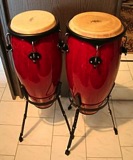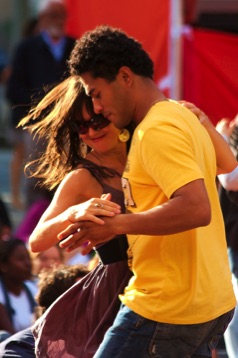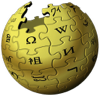

Help us to keep
this site alive
Advertise on our
site or give us a
Donation
Your
Banner
More Salsa
info on
Wiki Pedia
History
Merengue
Merengue - Couple Dance
The origins of the music are traced to the land of El Cibao, where merengue cibaeño and merengue típico are the terms most musicians use to refer to classical merengue. The word Cibao was a native name for the island, although the Spanish used it in their conquest to refer to a specific part of the island, the highest mountainous range. The term merengue cibaeño is therefore partially native and so merengue might also be a derivation of a native word related to song, music, dance, or festival. Another theory includes Western African words related to dance and music, based on the presence of African elements in merengue.
An early genre with similarities to merengue is the carabiné originating in the southern region of the territory of what is now the Dominican Republic, during the time of the French occupation. The name "carabiné" derives from the weapons called carbines (in French carabinier) that the soldiers did not dare to leave when a dance arrived, proceeding to dance with them on their shoulders. From the French word, the Spanish name of the new rhythm was derived, accentuating its pronunciation sharply on the "e".
Merengue was first mentioned in the mid 19th century with the earliest documented evidence being newspaper articles. Some of the articles inform about a "lascivious" dance, and also highlight merengue displacing the Tumba. The genre had originated within the rural, northern valley region around the city of Santiago called the Cibao. It later spread throughout the country and became popular among the urban population.
The oldest form of merengue was typically played on string instruments. When the accordion came to the island in the 1880s, introduced by German traders, it quickly became the primary instrument, and to this day is still the instrument of choice in merengue típico. Later, the piano and brass instruments were introduced to the genre.
Rhythm
Merengue dance
Merengues are fast arrangements with a 24 beat. The traditional instrumentation for a conjunto típico (traditional band), the usual performing group of folk merengue, is a diatonic accordion, a two–sided drum, called a tambora, held on the lap, and a güira. A güira is a percussion instrument that sounds like a maraca. It is a sheet of metal with small bumps on it (created with hammer and nail), shaped into a cylinder, and played with a stiff brush. The güira is brushed steadily on the downbeat with an "and-a" thrown in at certain points, or played in more complex patterns that generally mark the time. Caballito rhythm, or a quarter and two eighths, is also common. The double-headed drum is played on one side with a stick syncopation and on the other side with the palm of the hand.
The traditional (some say fundamental) signature rhythm figure of merengue is the quintillo, which is essentially a syncopated motif whose pattern is broken by five successive drumhead hits at the transition between every second and third beat, alternating between the hand and the stick. To purists, a merengue


Conga's
without quintillo is not truly a merengue, a viewpoint that has gradually disappeared as other alternate figures are used more frequently (as the one traditionally called jaleo, also known as merengue bomba, wrongly identified as a mixture of merengue and Puerto Rican bomba music, and which actually also has its roots in traditional merengue).
Three main types of merengue are played in the Dominican Republic today. Merengue típico, which is usually called perico ripiao, is the oldest style commonly played. In English perico ripiao means "ripped parrot", which suggests controversy but which is said to be the name of a brothel where the music was originally played. The other two types are merengue de orquesta (big-band merengue) and merengue de guitarra (guitar merengu
Merengue
Juan Luis Guerra - La Cosquillita
Merengue Dance
Argentina Segundo







